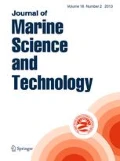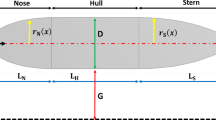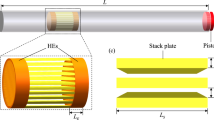Abstract
A bidirectional fluid–structure coupling method was developed to comprehensively understand the VIV characteristics of a 3D flexible marine riser. Through study VIV characteristics of the 3D riser in different flow conditions and by analysis of the structural characteristics of the riser’s responses, this study successfully captured the phenomena of switching of adjacent-order vibration modes and the characteristics of a “traveling wave” and a “standing wave” at both ends of the riser that cannot be obtained from 2D VIV studies. Analysis of the frequency of the structural vibration response characteristics found that the 3D flexible riser VIV showed multi-frequency vibration phenomena and the vibration response characteristics of a broadband spectrum in a high-speed flow condition. This research distinguished vortex forms at different locations of the riser, i.e., in the middle of the riser, mainly the “2P” or “P + S” forms occurred and at both ends of the riser, mainly the “2S” form appeared. After comparative analysis of the vortex forms of the riser wake in different speed flow conditions, this research identified that under a low flow velocity, the riser showed a 3D effect marginally, whereas under a high flow velocity, the riser showed a strong 3D effect.









Similar content being viewed by others
References
Sarpkaya T (2004) A critical review of the intrinsic nature of vortex-induced vibrations. J Fluids Struct 19:389–447
Williamson CHK, Govardhan RN (2004) Vortex-induced vibrations. Annu Rev Fluid Mech 36:413–455
Williamson CHK, Govardhan RN (2008) A brief review of recent results in vortex-induced vibrations. J Wind Eng Ind Aerodyn 96:713–735
Khalak A, Williamson CHK (1996) Dynamics of a hydroelastic cylinder with very low mass and damping. J Fluids Struct 10:455–472
Bearman PW (2003) Vortex shedding from oscillating bluff bodies. Annu Rev Fluid Mech 16:195–222
Jeon D, Gharib M (2001) On circular cylinders undergoing two-degree-of-freedom forced motions. J Fluids Struct 15:533–541
Jauvtis N, Williamson CHK (2004) The effect of two degrees of freedom on vortex-induced vibration at low mass and damping. J Fluid Mech 509:23–62
Guilmineau E, Queutey P (2004) Numerical simulation of vortex-induced vibration of a circular cylinder with low mass-damping in a turbulent flow. J Fluids Struct 19:449–466
Placzek A, Sigrist JF, Hamdouni A (2009) Numerical simulation of an oscillating cylinder in a cross-flow at low Reynolds number: forced and free oscillations. Comput Fluids 38:80–100
Bao Y, Huang C, Zhou D, Tu JH, Han ZL (2012) Two-degree-of-freedom flow-induced vibrations on isolated and tandem cylinders with varying natural frequency ratios. J Fluids Struct 35:50–75
Kang Z, Jia LS (2013) An experimental investigation of one-and two-degree of freedom VIV of cylinders. Acta Mech Sin 29:284–293
Wang XK, Wang C, Li YL, Tan SK (2017) Flow patterns of a low mass-damping cylinder undergoing vortex-induced vibration: transition from initial branch and upper branch. Appl Ocean Res 62:89–99
Han X, Lin W, Tang Y, Zhao C, Sammut K (2015) Effects of natural frequency ratio on vortex-induced vibration of a cylindrical structure. Comput Fluids 10:62–76
Han X, Lin W, Zhang X, Tang Y, Zhao C (2016) Two degree of freedom flow-induced vibration of cylindrical structures in marine environments: frequency ratio effects. J Mar Sci Technol 21:1–14
Han X, Zhang X, Tang Y, Qiu A, Lin W, Zhao C (2017) Dynamic mechanism of phase differences in one degree-of-freedom vortex-induced vibration of a cylindrical structure. J Eng Marit Environ. https://doi.org/10.1177/1475090217717356
Lie H, Larsen C M, Vandiver JK (1997) Vortex induced vibrations of long marine risers; model test in a rotating rig. In: The 16th international conference on offshore mechanics and arctic engineering
Lie H, Kaasen KE (2006) Modal analysis of measurements from a large-scale VIV model test of a riser in linearly sheared flow. J Fluids Struct 22:557–575
Wilde D, Wilde JJD, Huijsmans RHM (2004) Laboratory investigation of long riser VIV response. In: The 14th international offshore and polar engineering conference
Tognarelli MA, Slocum ST, Frank WR, Campbell RB (2004) VIV response of a long flexible cylinder in uniform and linearly sheared currents. In: The offshore technology conference
Chaplin JR, Bearman PW, Cheng Y et al (2005) Blind predictions of laboratory measurements of vortex-induced vibrations of a tension riser. J Fluids Struct 21:25–40
Ge F, Long X, Wang L, Hong YS (2009) Flow-induced vibrations of long circular cylinders modeled by coupled nonlinear oscillators. Sci China 52:1086–1093
Trim AD, Braaten H, Lie H, Tognarelli M (2005) Experimental investigation of vortex-induced vibration of long marine risers. J Fluids Struct 21:335–361
Srinil N (2011) Analysis and prediction of vortex-induced vibrations of variable-tension vertical risers in linearly sheared currents. Appl Ocean Res 33:41–53
Thorsen MJ, Sævik S, Larsen CM (2014) A simplified method for time domain simulation of cross-flow vortex-induced vibrations. J Fluids Struct 49:135–148
Thorsen MJ, Sævik S, Larsen CM (2015) Fatigue damage from time domain simulation of combined in-line and cross-flow vortex-induced vibrations. Mar Struct 41:200–222
Xue H, Wang K, Tang W (2015) A practical approach to predicting cross-flow and in-line VIV response for deepwater risers. Appl Ocean Res 52:92–101
Larsen CM, Halse KH (1997) Comparison of models for vortex induced vibrations of slender marine structures. Mar Struct 10:413–441
Shulz KW, Meling TS (2004) Multi-strip numerical analysis for flexible riser response. OMAE
Willden RHJ, Graham JMR (2004) Multi-modal vortex-induced vibrations of a vertical riser pipe subject to a uniform current profile. Eur J Mech B Fluids 23:209–218
Willden RHJ, Graham JMR (2005) CFD simulations of the vortex-induced vibrations of model riser pipes. OMAE
Willden RHJ, Graham JMR (2001) Numerical prediction of VIV on long flexible circular cylinders. J Fluids Struct 15:659–669
Yamamoto CT, Fregonesi RA, Meneghini JR, Saltara F (2002) Numerical simulation of the flow around flexible cylinders. OMAE
Hover FS, Davis JT, Triantafyllou MS (2004) Three-dimensionality of mode transition in vortex-induced vibrations of a circular cylinder. Eur J Mech B Fluids 23:29–40
Constantinides Y, Oakley OH, Holmes S (2007) CFD high L/D riser modeling study. In: ASME 2007 26th international conference on offshore mechanics and arctic engineering. American Society of Mechanical Engineers, pp 715–722
Holmes S, Oakley OH, Constantinides Y (2006) Simulation of riser VIV using fully three dimensional CFD simulations. In: 25th international conference on offshore mechanics and arctic engineering. American Society of Mechanical Engineers, pp 563–570
Xie F, Deng J, Zheng Y (2011) Multi-mode of vortex-induced vibration of a flexible circular cylinder. J Hydrodyn 23:483–490
Huang K, Chen HC, Chen CR (2010) Vertical riser VIV simulation in uniform current. J Offshore Mech Arct Eng 132:395–405
Huang K, Chen HC, Chen CR (2012) Vertical riser VIV simulation in sheared current. Int J Offshore Polar Eng 22:1369–1376
Bourguet R, Karniadakis GE, Triantafyllou MS (2011) Lock-in of the vortex-induced vibrations of a long tensioned beam in shear flow. J Fluids Struct 27:838–847
Bourguet R, Lucor D, Triantafyllou MS (2012) Mono- and multi-frequency vortex-induced vibrations of a long tensioned beam in shear flow. J Fluids Struct 32:52–64
Bourguet R, Karniadakis GE, Triantafyllou MS (2013) Multi-frequency vortex-induced vibrations of a long tensioned beam in linear and exponential shear flows. J Fluids Struct 41:33–42
Bourguet R, Karniadakis GE, Triantafyllou MS (2013) Phasing mechanisms between the in-line and cross-flow vortex-induced vibrations of a long tensioned beam in shear flow. Comput Struct 122:155–163
Benhamadouche S, Laurence D (2003) LES, coarse LES, and transient RANS comparisons on the flow across a tube bundle. Int J Heat Fluid Flow 24:470–479
Nicoud F, Ducros F (1999) Subgrid-scale stress modelling based on the square of the velocity gradient tensor. Flow Turbul Combust 62:183–200
Hinze JO (1975) Turbulence. McGraw-Hill Publishing Co., New York
Smagorinsky J (1963) General circulation experiments with the primitive equations. Mon Weather Rev 91:99–164
Feng Z, Jiang N, Zang F et al (2016) Nonlinear characteristics analysis of vortex-induced vibration for a three-dimensional flexible tube. Commun Nonlinear Sci Numer Simul 34:1–11
Sanaati B, Kato N (2013) Vortex-induced vibration (VIV) dynamics of a tensioned flexible cylinder subjected to uniform cross-flow. J Mar Sci Technol 18:247–261
Kang Z, Jia L (2013) An experiment study of a cylinder’s two degree of freedom VIV trajectories. Ocean Eng 70:129–140
Acknowledgements
This study was supported by the Guangxi natural science foundation (No. 2018GXNSFBA281138), a middle-aged and young teachers’ basic ability promotion project of Guangxi Zhuang Autonomous Region of China (2019KY0443), Qinzhou College Scientific Research Project (2016PY-SJ08), the Guangxi Major science and technology projects (No. AA17292007; No. AA17204001), and Haiou Talent Plan of Qinzhou City.
Author information
Authors and Affiliations
Corresponding authors
Additional information
Publisher's Note
Springer Nature remains neutral with regard to jurisdictional claims in published maps and institutional affiliations.
About this article
Cite this article
Han, X., Lin, W., Qiu, A. et al. Understanding vortex-induced vibration characteristics of a long flexible marine riser by a bidirectional fluid–structure coupling method. J Mar Sci Technol 25, 620–639 (2020). https://doi.org/10.1007/s00773-019-00663-y
Received:
Accepted:
Published:
Issue Date:
DOI: https://doi.org/10.1007/s00773-019-00663-y












